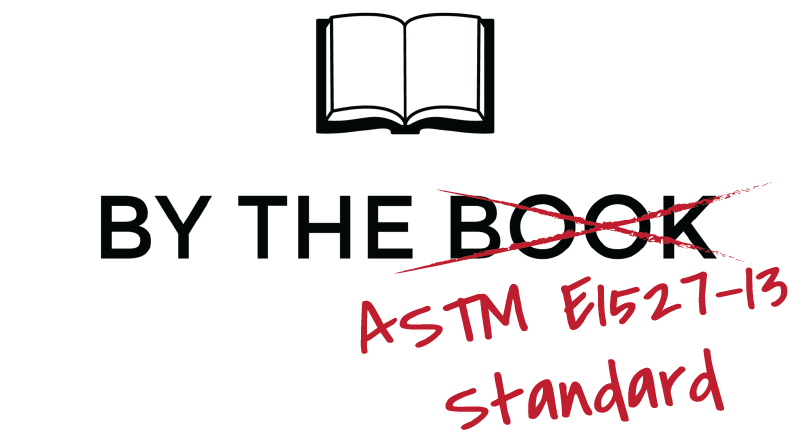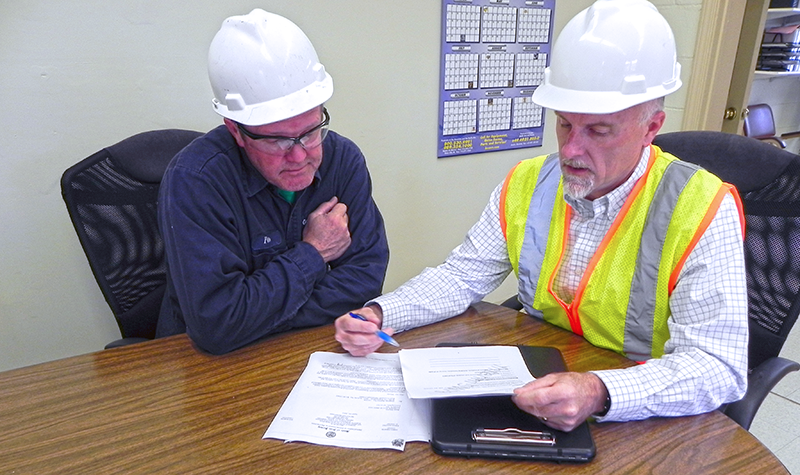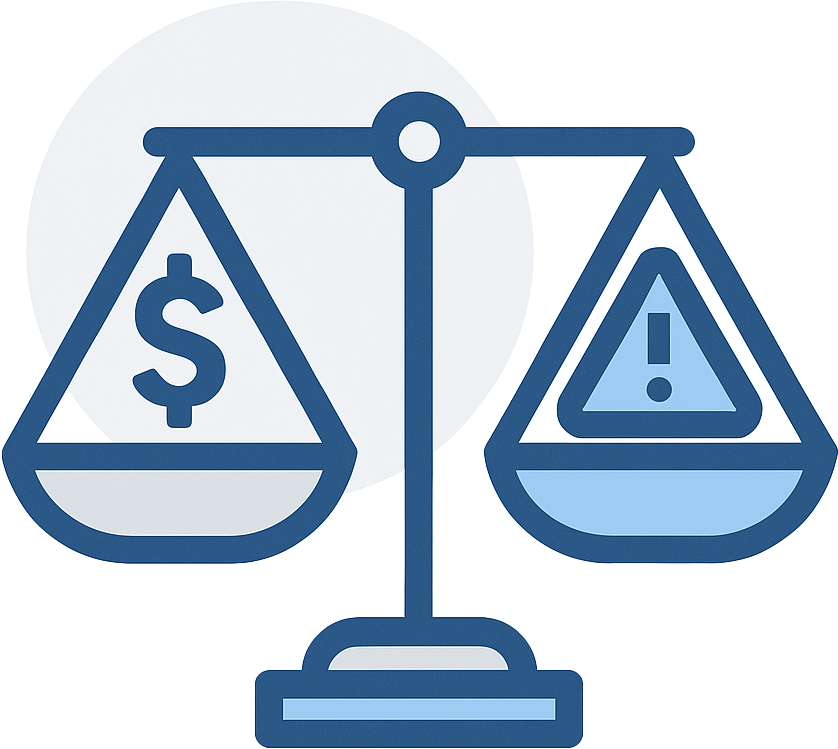We explain what the standard, "scope" items in a Phase I Environmental Site Assessment are as per ASTM E1527 - 21.
Quick Note: Even though this article is a few years old, we've updated some terms and language within this article to reflect the new ASTM E1527-21 standard used during the Phase I ESA process.
When it comes to purchasing a Phase I Environmental Site Assessment, many folks we talk to aren't entirely sure what they're getting. The issue is, the "standards" that define what is included in a Phase I ESA are created by ASTM International, a private organization, which can be somewhat confusing for the average person to get through.
Understanding what's included within a Phase I ESA is a very common issue we deal with when talking to customers on the phone or via email. Aside from people asking how much a Phase I Environmental Site Assessment costs or the basic question of what is a Phase I Environmental Site Assessment, asking what it includes is one of, if not the most common question we get.
Fortunately, when it's broken down and explained, it's easier to figure out what you're getting, and what's involved with a Phase I ESA. Unlike other consultants who want to throw jargon at you or mince their words, we know that helping you understand what a "scope" item in a Phase I ESA is, is vital to ensure customer satisfaction.

What are 'scope' items?
Before we start identifying the items, let's define a few things here. In a Phase I ESA, the items that are included as per ASTM standards are commonly referred to as "scope" items. Items that are not specifically mentioned, or specifically mentioned as outside the scope of a Phase I ESA in the ASTM standards are "non-scope" items.
For example, if you took your car in to get an oil change, your mechanic may drain the existing oil and put new oil back in your vehicle. In that case, those two items are the "scope" items for getting an oil change.
You may want additional things done while your car is in getting worked on, but those would be outside the "scope" of an oil change. Maybe you need new front wiper blades and your tires rotated. No problem, right? However, those wouldn't be part of getting an oil change. They can all be done at the same time, but they are above and beyond the standard practice of an oil change. And, those extra "non-scope" items are going to cost you more money.
You can apply the exact same logic to a Phase I ESA. The ASTM E1527 - 21 standard dictates what is included within a Phase I, meaning that's what you'll get. If you want other things, that's fine, but those are "non-scope" items above and beyond a Phase I ESA, which would mean you would incur more costs.

Who is ASTM anyway?
Let me get this out of the way right now - if you ever hear anyone call it the American Society for Testing and Materials they're wrong. That is an old organization, and that name is incorrect. ASTM has not been that American organization since 2001! If you hear an environmental professional call it that, run in the other direction because they're not up to date on current Phase I ESA affairs!
In fact, ASTM is kind of slang we use around here when we're writing or talking to people, and that slang word isn't entirely correct! It's actually ASTM International, who is an international organization that comes up with "standards" that people all over the globe use. In other words, not just America.
You may see the ASTM International logo stamped on goods, or hear other ASTM standards referenced in other industries, all of which are referring to ASTM International and an applicable standard.
They're called standards because that is the "standard" for that 'thing', whatever it may be. In this case, the Phase I ESA standard is the 'standard' and approved methodology for conducting the Phase I (the thing). And they're not regulations, not guidelines, not rules - they're standards, period, end of story.
In this case, the ASTM standard in question (as of the date of writing this article) is ASTM E1527 - 21, Standard Practice for Environmental Site Assessments: Phase I Environmental Site Assessment Process, which is the standard that dictates the scope items included in a Phase I ESA.
Just be aware there is an additional standard used for forested land or rural areas which is ASTM E2247 - 16, Standard Practice for Environmental Site Assessments: Phase I Environmental Site Assessment Process for Forestland or Rural Property. This standard is similar to E1527 - 21, however, it's specifically for forested or rural land, with some additional caveats.
Both of these standards say what is, and what is not included within a Phase I ESA, regardless of the property.

Why do I care about scope items in a Phase I ESA?
Chances are pretty good you're getting a Phase I ESA because you want liability protection. You don't want to purchase a property and find out 1, 5, or 20 years down the road it has some sort of contamination on site which you're now responsible for.
In order to get the level of liability protection you want, you purchase a Phase I ESA that is done by the books, by an environmental professional who meets the qualifications laid out in the standard. If your Phase I ESA isn't done by the books, you might not get the protection you want. If you get an environmental professional who doesn't meet the qualifications, you might not get the protection you want. In other words, do it by the books or you aren't getting a valid Phase I ESA.
From our experience, we've seen dozens of reports that are not done in accordance with the standard, and even more reports completed by people without the credentials necessary to be considered an environmental professional. Those reports aren't worth the paper they're printed on because they won't offer the protection the client or customer wanted in the first place.
Here are some additional articles which may help shine some light on what we mean:

Scope Items in a Phase I Environmental Site Assessment
Let's iron it out and explain what is and isn't scope within a Phase I ESA. Just so you know, in this instance we're only talking about ASTM E1527 - 21, not the Phase I standard for rural or forested properties.
First off, let's identify what a Phase I's objective is before we discuss what the items in it are:
7.1 Objective - The purpose of this Phase I Environmental Site Assessment is to identify, to the extent feasible pursuant to the processes prescribed herein, recognized environmental conditions in connection with the property.
In other words, find RECs in connection with a piece of property, to the extent possible as per the processes in the ASTM standard. Makes sense, right? If you aren't sure what RECs are or what the outcome of a Phase I ESA means, check out these articles:
The question is, how do we find the RECs?
7.2 Four Components - A Phase I Environmental Site Assessment shall have four components, as described as follows:
7.2.1 Records Review - Review of records; see Section 8,
7.2.2 Site Reconnaissance - A visit to the property; see Section 9,
7.2.3 Interviews:
7.2.3.1 Interviews with present and past owners, operators, and occupants of the property; see Section 10, and
7.2.3.2 Interviews with local government officials; see Section 11, and
7.2.4 Report - Evaluation and report; see Section 12.
So again, let's dissect that. A Phase I Environmental Site Assessment's scope items are: Records Review, Site Reconnaissance, Interviews, and the Phase I ESA Report itself. That's it. Bear in mind that all four of these items are explicitly detailed with very specific language in the ASTM standard, but let's talk about them a bit more regardless.
Records Review
This scope item in a Phase I ESA includes reviewing any and all records an environmental professional can get their hands on. This could be historical aerial photographs, tax maps, property records, topographic maps, land use records, building department records, Sanborn maps, city directories and listings (think old school yellow pages), and other various sources. In other words, any old records that can be used to help identify recognized environmental conditions included within a Phase I ESA.
Sometimes this information is easily obtainable via online resources, other times it requires visiting a government building. There is, however, a line which specifically states the information needs to be reasonably ascertainable, which is:
Record information that is reasonably ascertainable means (1) information that is publicly available, (2) information that is obtainable from its source within reasonable time and cost constraints, and (3) information that is practically reviewable.
So if it's costly, too time-consuming, private information, or the information won't really add anything to the Phase I ESA, then it's OK for an environmental professional to not review certain information. This may or may not be noted and included within a Phase I ESA itself.
Site Reconnaissance
This scope item in a Phase I ESA is simple enough to understand as well. This is a site visit to the subject property in question. Walking around, looking at things, taking pictures, etc., etc. The property itself, as well as the adjoining properties, are all of note, meaning the environmental professional will take a look at your property, your neighbors, and possibly even your neighbor's neighbor as well, depending on the current and past property use.
There are specific things to look out for, such as drums, pools of standing liquids, wells, unidentified containers and other storage tanks, soil staining, stressed vegetation, odors, etc. There are many, many things the environmental professional, or more likely, their team, are going to be looking for when conducting a site visit, some of which are specifically outlined within the standards.
Interviews
Again, simple enough. People associated with the property, either current owners, past owners, facility managers, tenants, neighbors, landlords, etc., can be interviewed and asked some general questions about the property in order to learn more about the property, and it's current and past usage.
Occasionally, if the Phase I ESA is being done secretly for whatever reason, interviews cannot occur at the request of the Phase I ESA purchaser. In this case, the environmental professional would note this as a "data gap". As you can probably imagine, a data gap is a gap in the collected data. In this instance, the "gap" in the "data" would be a lack of the interviews, and this would be noted within the report.
From our experience, interviews with government officials are few and far between, but this of course depends on the property and the project.

Phase I ESA Report
As you can imagine, the last scope item of a Phase I ESA is pretty self-explanatory. It's the actual Phase I ESA report itself. The environmental professional sits down, reviews all the records, reviews the information from the site reconnaissance and interviews, and writes the report. All the applicable copies of interviews, site reconnaissance notes, and records are included as well.
There are specific ways of preparing the report, including what should and shouldn't be included. One thing that the ASTM standards do specifically state is:
12.15 Recommendations - Recommendations are not required by this standard. A user should consider whether recommendations for additional inquiries or other services are desired. Recommendations are an additional service that may be useful in the user’s analysis of LLPs or business environmental risk.
Meaning, your report, unless you otherwise ask for it, may not include recommendations. Remember, the Phase I ESA's objective is just to IDENTIFY recognized environmental conditions, and the language specifically says that!
This is kind of an odd thing to explain to people, and something that we always discuss up front when talking with a new client. The standard specifically states recommendations don't need to be included, but many people don't know that and don't understand what that means. When we conduct a Phase I ESA, we specifically ask our clients if they want recommendations, and in what format. For example, we can either not include recommendations at all, include them within the report per the client's request, verbally communicate the recommendations to them, or provide them in another written manner. If the client wants recommendations within the report, we note that, because we're deviating from the scope of a Phase I, and really need to explain why.

Non-Scope Phase I ESA Considerations
So now that we specifically know what a Phase I ESA includes, it's also worth noting that the Phase I ESA standards specifically call out the following as non-scope items.
- Asbestos-containing building materials,
- Biological agents,
- Cultural and historic resources,
- Ecological resources,
- Endangered species,
- Health and safety,
- Indoor air quality unrelated to releases of hazardous substances or petroleum products into the environment,
- Industrial hygiene,
- Lead-based paint,
- Lead in drinking water,
- Mold,
- Radon,
- Regulatory compliance, and
- Wetlands.
In other words, none of those items are included within a Phase I ESA that is done strictly to scope.
If you as the customer want non-scope items in addition to a Phase I ESA, that's fine, but they most likely won't be included within the Phase I ESA report itself, and they'll also cost you extra. Think back to the oil change analogy; getting an oil change does not include a tire rotation!
Here are some extra articles on the subject in case you're interested in learning more:
If you're dealing with a Phase I practitioner who is automatically including any of those above items, buyer beware! You are buying a Phase I ESA with non-scope considerations right off the bat. If the environmental professional is deviating from the Phase I right off the bat, then it throws the validity of the report, and possibly the liability protection, into question.
If they aren't doing things by the book with regards to what they're looking for, who knows what else they aren't doing by the books! We've seen situations where reports are rejected, questioned, or even worse things have happened because a prior "environmental professional" decided to pick and choose what to include in the Phase I. In other words, not good!
The standards are crystal clear about what is, and what isn't in a Phase I ESA, so you, the customer should know what you're buying. When in doubt, ask the environmental professional, and if necessary, ask them to either show or read to you the standard that relates to the question you have.

Is testing or sampling a scope item in a Phase I ESA?
Another specific non-scope item that many people wonder about is testing or sampling. Long story short, no, testing or sampling is not part of a Phase I ESA.
No Sampling - The practice does not include any testing or sampling of materials (for example, soil, water, air, building materials).
So again, if for some reason you wanted sampling or testing to occur, that would be above and beyond the Phase I ESA itself.
Learn more about scope & non-scope Phase I ESA items.
If you want to learn more about what a Phase I ESA explicitly details, I encourage you to buy a copy of the ASTM standard which can be found HERE if you don't agree with what we're saying. It's $72.00 for a copy of the PDF, but I can assure you everything we've laid out here is mirrored within the standard itself. The standards are not hard to read and digest, and you can confirm we're not just making this up or interpreting things as we see fit!
Our goal is to educate our customers so everyone's on the same page when we prepare a Phase I ESA for them, and no one is left with unanswered expectations. If you have any questions about your Phase I ESA report, or are looking for a Phase I provider, click here to contact us or call us at 888-RMA-0230 anytime to learn more.



















